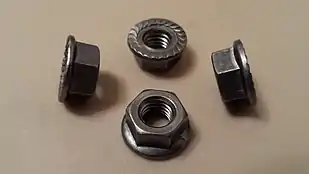Flange nut
A flange nut is a nut that has a wide flange at one end that acts as an integrated washer. This serves to distribute the pressure of the nut over the part being secured, reducing the chance of damage to the part and making it less likely to loosen as a result of an uneven fastening surface. These nuts are mostly hexagonal in shape and are made up of hardened steel and often coated with zinc.

The flange may be serrated to provide a locking action. On a serrated flange nut, the serrations are angled such that they keep the nut from rotating in the direction that would loosen the nut. Because of the serrations they cannot be used with a washer or on surfaces that must not be scratched. The serrations help in preventing the vibration of the nut from moving the fastener, thus maintaining the holding power of nut.
Flange nuts are sometimes provided with a swivel flange which helps in creating a more stable structure without affecting finished product like a serrated flange nut. Swivel flange nuts are mostly used in joining wood and plastic.[1]
A self-aligning nut, also known as a spherical nut[2] or leveling nut, is a type of nut that is used in applications where the fastener is not perpendicular to the surface the nut anchors to. It achieves this action by using a flange nut inside a specially shaped dished-out washer. They are commonly used in the aerospace industry. If this nut were not used the object would have to be spot faced perpendicular to the fastener.[3]
Flange nuts (and bolts) are widely used in automobiles and electronic products.
The following specifications define flange nuts:
See also
References
- Barrett, Rich, Fastener Design Manual (PDF), retrieved 2012-08-03.
- Spherical nuts & washers, archived from the original on 2016-02-21, retrieved 2009-04-20.
- Smith, Carroll (1990), Carroll Smith's Nuts, Bolts, Fasteners, and Plumbing Handbook, MotorBooks/MBI Publishing Company, p. 108, ISBN 0-87938-406-9, archived from the original on 2015-11-05.
- DIN 6923 - flange nut specification.
